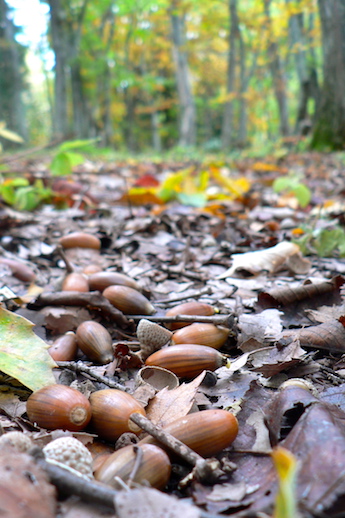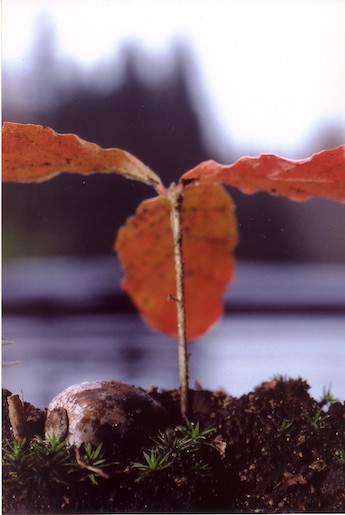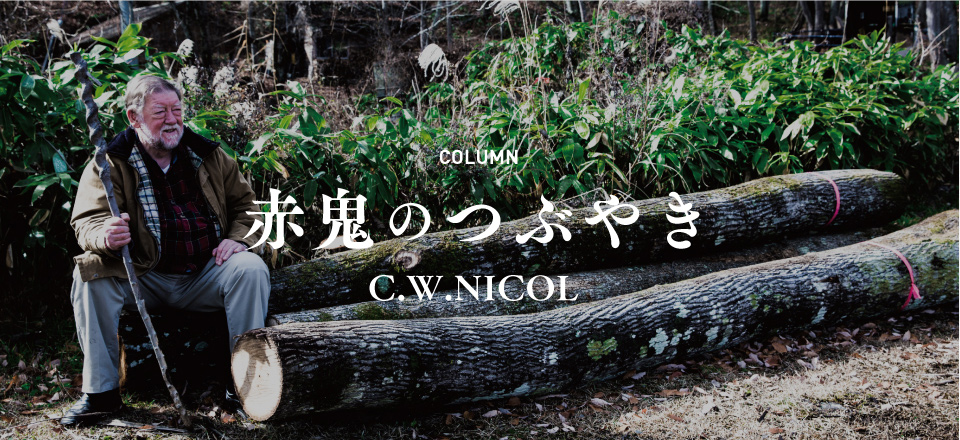Column
【赤鬼のつぶやき C.W.ニコル】どんぐり(Acorn)
今月から私のコーナーがスタートしました。何を書こうかといろいろ考えたのですが、第一弾は岡村製作所の家具としてお馴染みの木を皆様にご紹介しようと思います。
木にはそれぞれ個性や特徴があるのと同時に人間の歴史まで変えてしまう力を持っています。そんな木の魅力をお伝えできたら嬉しいです。
それから皆様のリクエストにもお答えしたいと思っています。
これから、宜しくお願い致します。


どんぐりの実をつけるカシやオーク(ナラ)の仲間は、世界中に約500種類以上が知られています。日本の固有種だけで16種類が、沖縄から北海道に分布しています。北信州の黒姫にあるアファンの森にはそのうち2種類、コナラとミズナラがもともと生育していますが、イングリッシュオーク、北米のレッドオーク、そしてカシワというとても大きな葉をつける種類のオークを、研究のために別の場所で育てています。
なかでもわたしが少年のころから慣れ親しんでいるのはイングリッシュオークで、ラテン語の学名では「強い」「硬い」ナラの木、という意味のQuercus roburと呼ばれます。オークはケルト人にとって神聖な木で、ケルトの祈りを捧げる場所といえば、古い巨木、泉や巨大な丸石が、オークの森の中にあるところが多いです。
世界最強を誇ったイギリスの海軍もまた、オークの木によって支えられていました。船、建造物、家具、さまざまな道具や家庭用品、武器、あらゆるものに材が使われました。薪や炭にすれば燃料にもなります。若いオークの樹皮では、皮をなめしています。そしてどんぐりの実は、小麦や豆類の農耕をはじめる前には、大切な食糧源でもありました。ヨーロッパやネイティブ・アメリカンの文化では、いまでもどんぐりを集めて食生活に取り入れています。
カビが生えたり穴が開いたりすると、どんぐりは成熟することができません。熟したどんぐりを食べるには、冷たい水にさらすか、茹でて流水で洗ってタンニンという酸の苦味を取りのぞかなくてはいけません。そうすれば、実を丸のままでも、挽いて粉にしたり、小麦粉に混ぜ込んでも食べることができます。
南スペインでは、どんぐりが樹から落ちる季節になると豚を放牧するところがあります。そして豚は、どんぐりの実を拾って食べます。「どんぐり豚」はよく太り、味わいも深く、かつ健康で脂肪が少ない肉が特徴です。この「ハモン・イベリコ」は、世界で最高級の、最も人々から愛されているハムでしょう。
イギリスのニュー・フォレストという森では、「どんぐり豚」の風習がいまでも続いていて、豚を森に放して、カシやブナの熟したどんぐりを食べさせることを「パナージュ」といいます。
絶滅が危惧される植物や、地面に営巣する小動物を豚が食べてしまわないように、そして森の樹々が傷つけられないように、もちろん豚とその肉のためにも、どんぐりが落ちている季節だけ豚を放し、その実を食べさせるのは理に適っているといえます。じつは数年前に、黒姫にあるわたしの土地でも試してみたことがあるのです。豚肉も、自家製のハムも、すばらしく美味しかった!

どんぐりは、魔法の力を持っているに違いありません。これまでにたくさんの物語が、この小さなどんぐりたちから生まれてきたのですから!
C.W.ニコル
2016年4月10日
写真提供:C.W.ニコル・アファンの森財団
(日本語訳:津久井 文)
I am starting a series of essays for the website of OKAMURA CORPORATION. From the onset I would like to introduce the kind of trees we all are familiar with.
Trees have the power to change history. Each species of tree, even individual trees, have a something special. Every kind of tree has distinctive features. Let me talk about it in this series of writing.
If you have any requests as to what kind of stories you want to read I will be happy to nurture your enjoyment.
Over five hundred species of acorn-bearing species of oak trees have been identified world-wide. In Japan there are sixteen native species, growing from Okinawa to Hokkaido. In our Afan woodland trust here in Kurohime, northern Nagano we have two species that are native to this area; ko nara and mizu nara, but for study we have separately grown English oaks, American red oaks and Japanese kashi (that’s the oak with the really big leaf).
The oak tree I knew as a boy was the English oak, with its Latin name of Quercus robur, meaning ‘strong’ and ‘hard wood.’ To the Celts the oak was a sacred tree and often the Celtic places of worship were in groves of oaks which had ancient trees and probably a spring or a huge boulder.
The English built their mighty navy with oak trees. Oak was used for ships, buildings, furniture, tools, utensils and weapons. The wood gave fuel, in firewood or charcoal. Bark from young oak trees was used in tanning leather. Acorns were a common source of food before people turned to farming grains and beans, but even so, all over Europe and among Native Americans, acorns are still gathered and used as food.
The acorns must be ripe, with no mildew or worm holes. The tannic acid, which makes acorns bitter, has to be leached, either with cold running water or by boiling and then washing with cold water. Acorn nuts can be used whole, or ground or pounded into flour.
In southern Spain, when acorns begin to drop from the trees, pigs are let loose to forage. ‘Acorn-finished’ pork has more fat, yet the meat is more tasty, healthy and lean. ‘Jamon iberico de bellota’ is the most expensive and perhaps most popular ham there is.
This custom of ‘acorn-finishing’ pigs is still carried on in the New Forest of England. The old term for letting pigs feed on ripened acorns or beech mast is ‘pannage.’
As long as pigs are kept away from endangered plants or small animals (ground nesting birds etc.) this custom is good for pigs, pork, and for the health of the woods. We did try it for some years here in Kurohime, on a patch of land that I owned, and the pork and ham was superb!
So much has been written about acorns that the little acorn surely has some mighty magic!
C.W. Nicol
April 10th. 2016
C.W.ニコル
作家・1940年イギリス南ウェールズ生まれ。1995年日本国籍取得。カナダ水産調査局北極生物研究所の技官・環境局の環境問題緊急対策官やエチオピアのシミエン山岳国立公園の公園長など世界各地で環境保護活動を行い、1980年から長野県在住。1984年から荒れ果てた里山を購入し「アファンの森」と名づけ、森の再生活動を始める。2005年、その活動が認められエリザベス女王から名誉大英勲章を賜る。2011年、2016年に天皇、皇后両陛下がアファンの森をご視察された。





